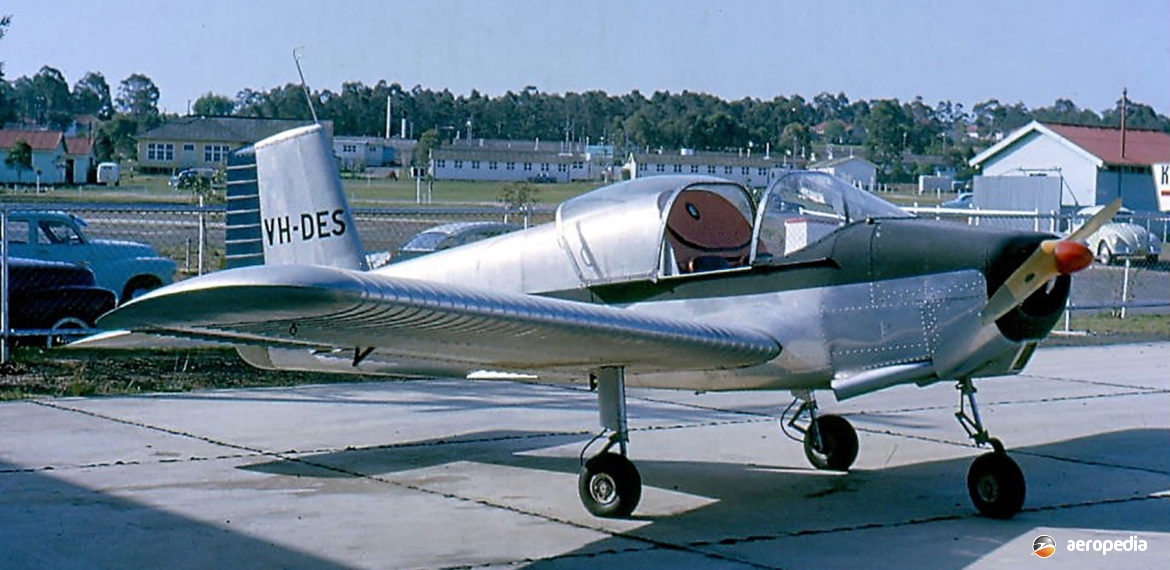Photograph:
Thorp T-111 VH-DES (c/n 13) at Bankstown, NSW (David C Eyre)
Country of origin:
United States of America
Description:
Two-seat light cabin monoplane
Power Plant:
One 56 kw (75 hp) Lycoming O-145-B2 four-cylinder horizontally-opposed air-cooled engine
Specifications:
- Wingspan: 7.62 m (25 ft)
- Length: 5.5 m (18 ft 0½ in)
- Height: 1.9 m (6 ft 2¾ in)
- Wing area: 9.72 m² (104.6 sq ft)
- Max speed at sea level: 202 km/h (125 mph)
- Cruising speed at 75% power: 198 km/h (123 mph)
- Stalling speed flaps down power on: 73 km/h (45 mph)
- Max rate of climb at sea level: 229 m/min (750 ft/min)
- Service ceiling: 3,810 m (12,500 ft)
- Range: 587 km (365 miles)
- Fuel capacity: 78 litres (17 imp gals)
- Empty weight: 352 kg (775 lb)
- Baggage capacity: 18 kg (40 lb)
- Loaded weight: 576 kg (1,270 lb)
History:
The Thorp T-111 Sky Skooter was designed by John W Thorp as a development of his earlier design, the Little Dipper. The prototype was flown on 15 August 1946 powered by a 48 kw (65 hp) Lycoming engine and early production machines were produced by Thorp Engineering. Occasionally modifications were made to the design. Two basic versions were produced, the T-111 with a 56 kw (75 hp) Lycoming O-145-B2 engine, and the T-211 with a 67 kw (90 hp) Continental C90-12F engine, both of which increased the cruising speed and initial rate of climb of the original design. Another refinement was the change in shape of the cockpit canopy and rear fuselage, thus reducing turbulence around the cockpit. Many other minor changes were introduced during the 14 years that the prototypes were flown in the USA.
In place of the usual structure of spars and ribs in the wing construction, the Sky Skooter had a stressed skin of corrugated duralumin over six basic rib forms (three in each wing), this method of construction giving adequate strength with minimum weight. The simplicity of construction also permitted greater speed in production.
Only small numbers of the original aircraft were produced when Tubular Aircraft Products took over production of an improved version of the T-111, this company receiving certification on 20 April 1964. A further 100 examples were built. This new model was fitted with the Continental O-200A engine and, including some detailed refinements, entered production in 1965 In 2002 Indus Aviation Inc of Dallas, Texas bought the Type Certificate and renamed it as the Sport E, the aircraft to be built by TAAL in India. These new production aircraft were fitted with either the 75 kw (100 hp) Teledyne Continental O-200A engine, or the 90 kw (120 hp) Jabiru 3300 engine.
In 1998 it was announced that DM Aerospace Ltd in the United Kingdom had acquired the Type Certificate for the Thorp T-211 and had begun manufacturing at a facility in Manchester, fitting it with a Jabiru 3300 engine, this unit producing 75 kw (100 hp) at 2,750 rpm and weighing 73 kg (161 lb).
Since then the type has entered production and been marketed in the United States by Indus Aviation Inc of Dallas, Texas, as the Indus Aviation Thorpedo with an all-up weight of 576 kg (1,270 lb) and, with the Jabiru 3300 engine of 89 kw (120 hp) driving a Sensenich wooden two-blade propeller, having a cruising speed of 167 km/h (104 mph).
Two T-111 Sky Skooters were imported to Australia by Descon Aviation in the early 1960s. Both aircraft were fitted with the 56 kw (75 hp) Lycoming O-145-B2, but some years passed before Australian Certificates of Airworthiness were granted. The first VH-DES (c/n N13 – later A8) was registered in June 1967 and in recent years has been based at Walcha, NSW; and the second VH-EQF (c/n N21 – later 9 – ex VH-CON ntu) was registered in November 1969, the latter being damaged in a landing at Wedderburn, NSW in 1992.

